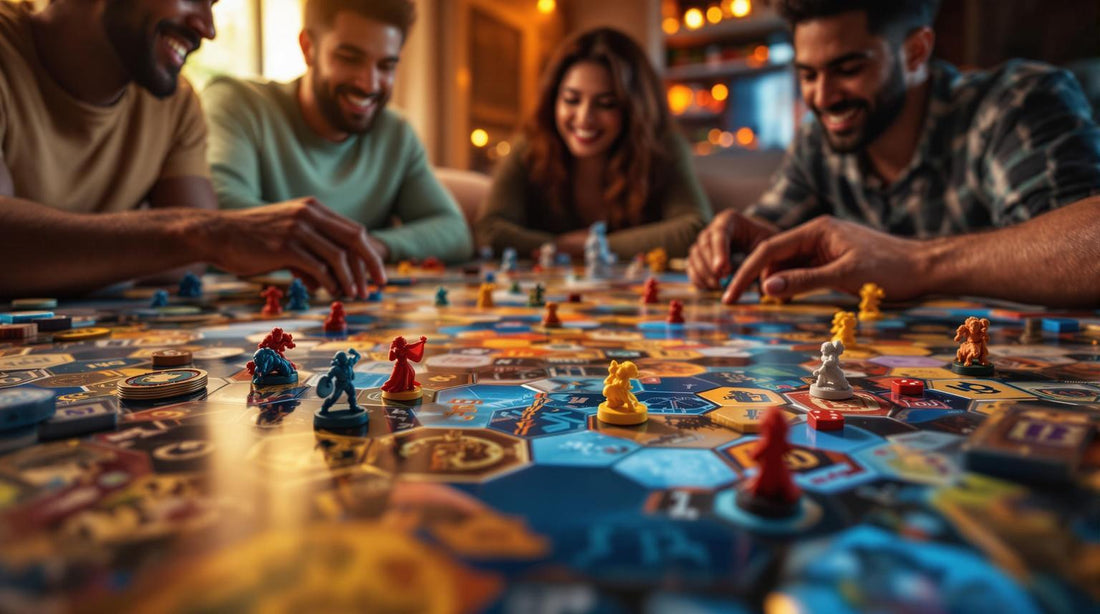Discover the Best Board Games for Every Player

Board Game Communities: Key Player Demographics
Board games are more popular than ever, with players of all ages and backgrounds diving into the hobby. Here's what you need to know about the people who play, why they play, and how the industry is evolving:
-
Who Plays?
Players range from kids to seniors, with game preferences shifting by age group:- Kids (4-12): Simple, fun, and educational games.
- Teens (13-19): Fast-paced party and social games.
- Young Adults (20-35): Strategy and complex Euro-style games.
- Adults (36-55): Strategic and thematic games like deck builders.
- Seniors (56+): Classic games and brain teasers for mental stimulation.
-
Why Play?
Board games offer social connection, mental challenges, and a break from screens. They bring people together at home, cafés, or community events. -
Industry Trends:
- Game creators now focus on age-specific designs and inclusive experiences.
- Gender diversity is increasing, with efforts to make board gaming more welcoming.
- Local game stores and brands like Brain Games build communities through events, discounts, and accessible game options.
Bottom Line: Board games are thriving because they connect people, challenge minds, and appeal to a wide range of interests. Whether you're a casual player or a hardcore strategist, there's a game for you.
The Psychology of Board Games: Understanding Player Behavior and Motivation
Player Age Groups
Age Distribution Data
Board gaming has become a hobby that spans multiple generations, drawing in players of all ages. The complexity of a game and its rules often dictate its appeal to different age groups. Younger players tend to enjoy games with straightforward mechanics, while adults are drawn to options with more intricate strategies.
Manufacturers and retailers are increasingly designing products with specific age preferences in mind. This approach helps create gaming communities where everyone can find something suited to their interests and skill levels. These trends play a big role in shaping how games are designed, as detailed below.
Game Choices by Age
Age plays a major role in the types of games people enjoy, influenced by factors like cognitive abilities, social dynamics, and personal interests. Here's a breakdown of how game preferences align with different age groups:
| Age Group | Popular Game Types | Key Features |
|---|---|---|
| Children (4-12) | Family games, dexterity games | Easy-to-follow rules, fun themes, educational elements |
| Teens (13-19) | Party games, social deduction | Fast-paced gameplay, group-focused interaction |
| Young Adults (20-35) | Strategy games, euro-style | Complex mechanics, longer game sessions |
| Adults (36-55) | Worker placement, deck builders | Strategic gameplay, strong thematic elements |
| Seniors (56+) | Classic games, brain teasers | Mental stimulation, familiar and simple mechanics |
These preferences highlight the diversity within the board gaming community. For example, Brain Games Publishing’s "ICECOOL® Universe" is a hit with children due to its easy mechanics and fun theme. Meanwhile, their "Logic Cards" series appeals to older players looking for mental challenges through brain teasers.
Physical and mental abilities also influence game choices. Younger players often enjoy games that involve dexterity and vibrant, engaging themes. In contrast, older adults prefer games that challenge their minds without requiring extensive physical manipulation of game pieces.
Family-friendly games like "Karakum" are great for bridging age gaps. With simple rules that cater to all skill levels, these games encourage intergenerational connections and make it easy for everyone to join in.
Designing games that cater to specific age groups helps keep the board gaming community thriving and inclusive.
Gender in Board Gaming
Gender Statistics
Board gaming has traditionally been a male-heavy activity. However, things are slowly changing as more diverse groups of players join the hobby. This shift has sparked efforts to create games and spaces that feel more welcoming to everyone.
Making Games More Welcoming
The board gaming community is taking steps to make the hobby more inviting. Initiatives like inclusive events and mentorship programs are helping newcomers feel at ease. Retailers such as Brain Games are also playing a role by offering game selections that cater to a wider audience and creating family-friendly environments that encourage people to dive into board gaming.
sbb-itb-1ed942f
Why People Play Board Games
Social and Mental Benefits
Board games bring people together and keep minds sharp. They offer a chance to connect with others while challenging players mentally. In a world often dominated by screens, these games provide a chance to unplug and enjoy face-to-face interaction. Whether solving puzzles or strategizing, players get both entertainment and meaningful social engagement.
Playing Habits and Groups
People approach board games in different ways, often influenced by the setting and the group they're with. Some meet at home, others gather at game stores or cafés. The type of game also impacts the vibe - party games are great for larger crowds, while strategy or family games work better in smaller, close-knit groups. How often people play and the way they play often depends on their lifestyle, but the common thread is a shared desire to step away from screens and enjoy real-world connections.
Brain Games in the Community
Shop Brain Games
Brain Games stands out in the board gaming world with a wide selection of titles. Their catalog includes family favorites like ICECOOL® Universe for younger players and strategy-based games such as Karakum for all ages. Most family-friendly games are priced between $19.95 and $24.95, with options like Flow at $24.95 and Voila currently on sale for $18.71. These offerings help create a sense of connection within the gaming community.
Community Building
Brain Games builds strong communities by offering products and programs designed to bring people together. Their games are known for combining straightforward rules with engaging gameplay, making them suitable for everyone from beginners to seasoned players.
Here’s how they contribute to community growth:
- Family-Friendly Games: Titles like Karakum encourage quality time with easy-to-learn gameplay.
- Educational Options: Products like Logic Cards and puzzle sets provide both fun and mental challenges.
- Discount Programs: First-time buyers get 20% off, and newsletter subscribers enjoy a 10% discount on future purchases.
Brain Games also develops their own games to cater to a range of preferences and skill levels. Plus, they back their in-house titles with a lifetime guarantee, ensuring gaming groups can enjoy their purchases worry-free. These efforts not only strengthen player engagement but also help the board gaming market grow.
Summary and Findings
Market Growth Areas
The board game industry is seeing shifts as new groups of players become more engaged. Younger adults and families are showing increased interest, particularly in strategy games with complex mechanics and family-friendly options that combine education and entertainment. Another emerging trend is the integration of digital elements into traditional board games, opening up possibilities for hybrid gaming experiences.
Store Impact on Communities
Local specialty game stores play a key role in building board game communities. Shops like Brain Games create spaces for players to connect by hosting events and offering a wide range of both classic and modern games. These efforts not only attract newcomers but also help strengthen and sustain local gaming groups.






